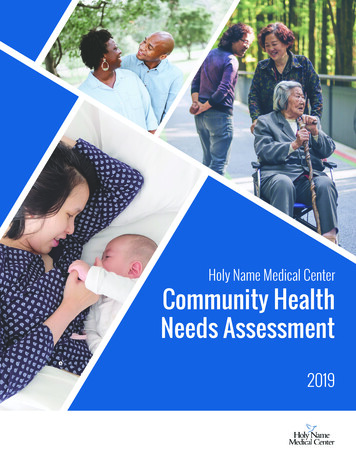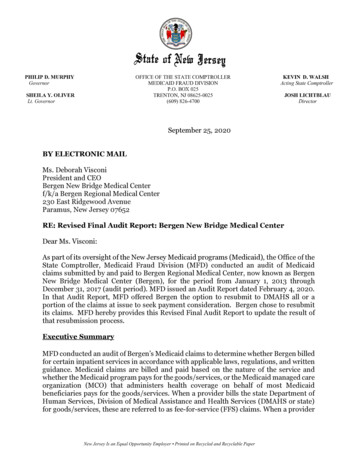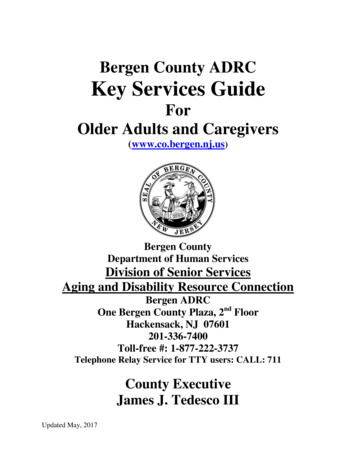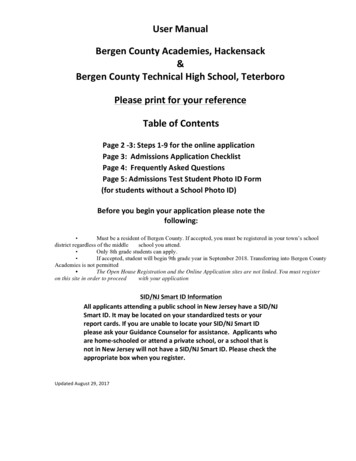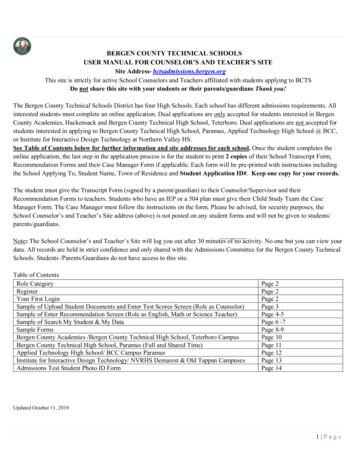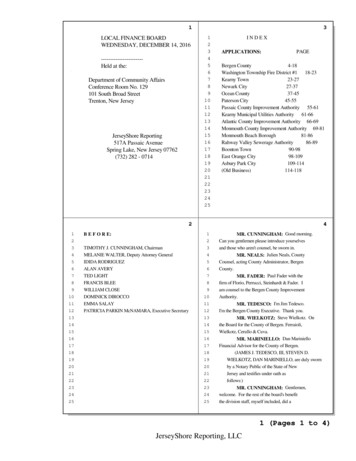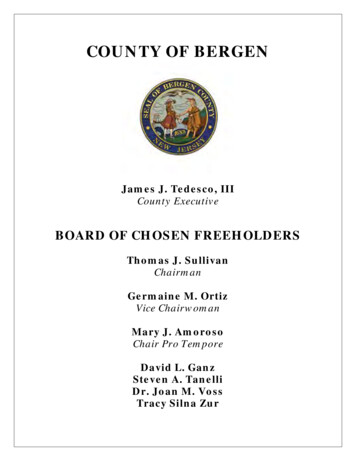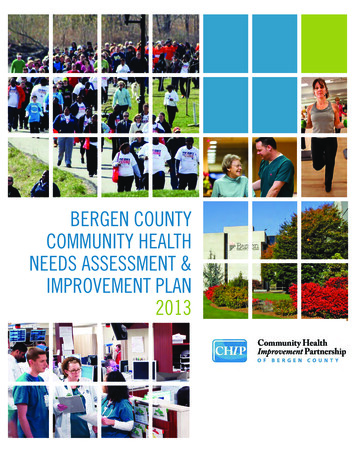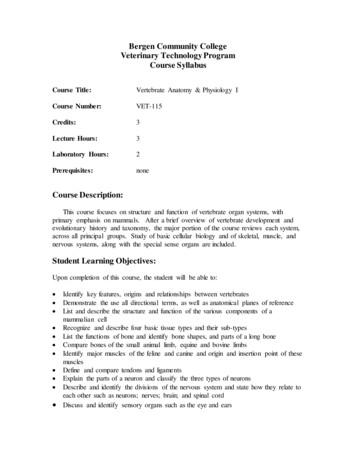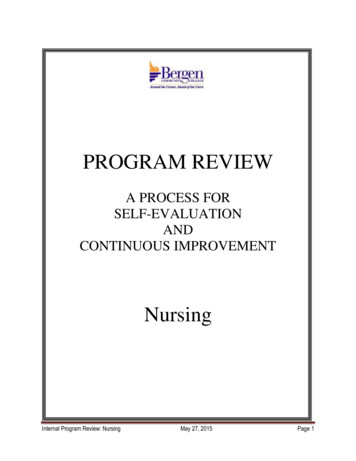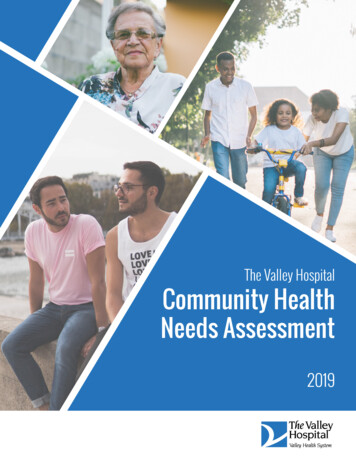
Transcription
Bergen New BridgeThe MedicalValley HospitalCenterCommunity HealthNeeds Assessment2019
ACKNOWLEDGMENTSThe Bergen County Community Health Needs Assessment (CHNA) and Strategic Planning process wasmade possible through the generous support of Bergen New Bridge Medical Center, Englewood Health,Hackensack Meridian Health Hackensack University Medical Center, Hackensack Meridian HealthPascack Valley Medical Center, Holy Name Medical Center, Ramapo Ridge Psychiatric Hospital (a part ofChristian Health Care Center), and The Valley Hospital. Representatives from these seven hospitals,along with representatives of the Bergen County Department of Health Services (BCDHS) and theCommunity Health Improvement Partnership (CHIP) of Bergen County, worked collaboratively for morethan a year to plan and execute this assessment. A Steering Committee comprised of representativesfrom each hospital and BCDHS guided this project. John Snow, Inc. (JSI) was hired by the SteeringCommittee to assist with the assessment.Hundreds of individuals who live, work, and learn in Bergen County were engaged to participate in theassessment process. JSI administered a mail-based random household survey and receivedapproximately 1,350 responses; the survey oversampled in areas of the County with higher percentagesof Black/African American residents, Hispanic/Latino residents, and low-income households to achieve asample that was representative of Bergen County demographics. Information was also gathered throughinterviews, focus groups, and community listening sessions. Finally, over 350 community residentsresponded to a web-based survey to capture opinions and perceptions of leading social determinants ofhealth, barriers to care, vulnerable populations, and access to health care services.The information gathered throughout this assessment will allow the hospitals, the BCHDS, the CHIP, andhealth and social service providers to gain a better understanding of health needs and barriers to care inBergen County. The assessment results will be used to guide the development of strategic plans toaddress these issues and improve where, when, and how healthcare is provided. The SteeringCommittee would like to extend their sincere appreciation to all those who invested their time, effort,and expertise to ensure the development of a comprehensive and robust assessment.2019 BERGEN COUNTY COMMUNITY HEALTH NEEDS ASSESSMENT STEERINGCOMMITTEECarolyn Bryan, Hackensack Meridian Health Pascack Valley Medical CenterDonnalee Corrieri, Bergen New Bridge Medical CenterColette Cummings, The Valley HospitalRebecca Dauerman, Ramapo Ridge Psychiatric Hospital (part of Christian Health Care Center)Balpreet Grewal-Virk, Hackensack Meridian Health Hackensack University Medical CenterMarianne Kennelly, Ramapo Ridge Psychiatric Hospital (part of Christian Health Care Center)Marla Klein, Bergen County Department of Health ServicesElisabeth Lucas, The Valley HospitalLauren Menkes, Englewood HealthElizabeth Rubock, Bergen County Department of Health ServicesJennifer Yanowitz, Englewood HealthCatherine Yaxley, Holy Name Medical CenterThe Valley Hospital: Community Health Needs Assessment 2019 Page 1
EXECUTIVE SUMMARYOVERVIEW AND PURPOSEThis Community Health Needs Assessment (CHNA) and the associated Implementation Strategy (IS)were prepared for The Valley Hospital – a fully accredited, acute-care, not-for-profit hospital servingindividuals in Bergen County and beyond. The CHNA was a collaborative effort involving the CommunityHealth Improvement Partnership (CHIP) of Bergen County, the Bergen County Department of HealthServices (BCDHS), The Valley Hospital, and the other six acute care hospitals in Bergen County: BergenNew Bridge Medical Center, Englewood Health, Hackensack Meridian Health Hackensack UniversityMedical Center, Hackensack Meridian Health Pascack Valley Medical Center, Holy Name Medical Center,and Ramapo Ridge Psychiatric Hospital (a part of Christian Health Care Center). Representatives fromeach of these entities worked collaboratively to guide the overall assessment methods and approach,and to identify priority health issues and populations.As a non-profit hospital, Valley is committed to giving back to their community. The Hospitalacknowledges its role as a critical community resource, but also recognizes the value in collaboratingwith community partners to identify, educate, prevent, and address issues that prevent communityresidents from accessing the health services they need. Through its community benefit programming,Valley strives to create and support opportunities for residents of the service area to lead healthy andproductive lives.The assessment efforts that took place over the past year engaged hundreds of residents in BergenCounty, as well as a wide range of other community stakeholders, including service providers,community advocates, health and public health officials, faith leaders, and representatives fromcommunity-based organizations.This CHNA provides information that will be used to guide the development of services and programsand ensure they are delivered in ways that are responsive to those in its service area. This CHNA andValley’s Implementation Strategy will allow the Hospital to meet federal Community Benefitsrequirements per the Federal Internal Revenue Service (IRS) as part of the Affordable Care Act.The Valley Hospital: Community Health Needs Assessment 2019 Page 2
APPROACH AND METHODSThe assessment began in December 2018 and was conducted in three phases, which allowed for thecollection of an extensive amount of quantitative and qualitative data (Phase 1); engagement ofcommunity residents, key stakeholders, and service providers (Phase 2); and analysis and prioritizationof findings for use in developing a data-driven Implementation Strategy (Phase 3).2019 Bergen County CHNA: Project PhasesPhase 1Preliminary Assessment andEngagement Secondary Data CollectionKey Informant InterviewsResource InventorySteering Committee MeetingsPhase 2Targeted Engagement Bergen County RandomHousehold SurveyFocus GroupsCommunity Listening SessionsBergen County CommunityHealth Perceptions SurveySteering Committee MeetingsPhase 3Strategic Planning and Reporting Steering CommitteePrioritization MeetingIndividual Hospital andBCHDS/CHIP PrioritizationMeetingFinal ReportingMany individuals from across Bergen County were engaged in the assessment and planning process,including: Health and social service providersBCDHS and CHIP leadership and staffFaith leadersCommunity residents Hospital leadership, clinicians, and staffHealth and public health officialsCommunity organizers and advocatesTHE VALLEY HOSPITAL COMMUNITY HEALTH PRIORITIES AND VULNERABLEPOPULATIONSThe CHNA was designed as a population-based assessment, meaning the goal was to identify a full rangeof community health issues across the demographic and socioeconomic segments of the population. Theissues identified were framed in a broad context to ensure that the breadth of unmet needs andcommunity health issues were recognized.An integrated analysis of the assessment activities framed community health issues into four priorityareas for The Valley Hospital: health education, prevention, and wellness; chronic and complexconditions; mental health and substance use; and access to care. A fifth crosscutting priority area wasalso identified: social determinants of health.To plan community health initiatives and to comply with federal guidelines, there was an effort toidentify segments of the population with complex health needs or that face significant barriers to care.With this in mind, six population segments were identified: older adults, children and families, lowresource individuals, individuals with chronic/complex conditions, and racially/ethnically diversepopulations.The Valley Hospital: Community Health Needs Assessment 2019 Page 3
HealthEducation,Prevention,and WellnessChronic andComplexConditionsMentalHealth andSubstanceUseAccess toCareOlder AdultsChildren andFamiliesLow-ResourceIndividualsIndividuals verse PopulationsSocial Determinants of HealthKEY FINDINGS/THEMES BY PRIORITY AREABelow is a listing of key findings and themes by priority area, with social determinants of health andaccess to care combined into a single area. These findings were used as the basis for the development ofImplementation Strategies for the CHIP of Bergen County and individual hospitals. For more detailedfindings, data sources, and data on disparities by gender identity, race/ethnicity, income, and age,please see the full Community Health Needs Assessment report. Priority areas are listed in the order inwhich they are discussed in this Community Health Needs Assessment report and are not hierarchical.Priority Area: Health Education, Prevention, and Wellness All-cause and premature mortality were lower in Bergen County than New Jersey overall One-third (33.2%) of Bergen County Random Household Survey respondents were overweight, whileapproximately one in five were obese (22.8%) Nearly a third (32.9%) of Bergen County Random Household Survey respondents reported that they did notparticipate in any physical activity or exercise in the past 30 days Over 70% of Bergen County Random Household Survey respondents reported that they had a primary carevisit and a dental visit within the past year Individuals engaged during this assessment prioritized the risk factors associated with chronic and complexconditions (e.g., obesity, poor nutrition, sedentary lifestyle) as key issues of concernPriority Area: Chronic and Complex Conditions Heart disease (#1) and cancer (#2) were the leading causes of death in Bergen County Approximately 1 in 4 (26.5%) Bergen County Random Household Survey respondents had been diagnosed withhigh blood pressure Approximately 1 in 10 (9.7%) Bergen County Random Household Survey respondents had ever been diagnosedwith cancerThe Valley Hospital: Community Health Needs Assessment 2019 Page 4
Approximately 1 in 10 (11.5%) Bergen County Random Household Survey respondents had ever beendiagnosed with diabetes. 14.1% of Bergen County Random Household Survey respondents had been diagnosed with asthma Influenza and pneumonia mortality rates were significantly high in Bergen County compared to New Jerseyoverall Individuals engaged in this assessment identified older adults, especially those with multiple chronicconditions and those who lack a regular caregiver, as a vulnerable populationPriority Area: Mental Health and Substance Use 6.8% of Bergen County Random Household Survey respondents reported that their mental health was poorfor 15 or more days in the past month Nearly 1 in 10 (9.7%) of Bergen County Random Household Survey respondents had ever been diagnosed with a depressive disorderOver 1 in 10 (12.7%) of Bergen County Random Household Survey respondents had ever been diagnosed withan anxiety disorder18.9% of Bergen County Random Household Survey respondents were current smokersIndividuals engaged in this assessment characterized e-cigarette and vaping as a critical concern, especially foryouth and adolescents15.4% of Bergen County Random Household Survey respondents reported binge drinking in the past 30 daysDrug-related deaths in Bergen County have increased since 2014, from 8.8 deaths to 13.8 deaths per 100,000The number of suspected opioid-overdose deaths has continued to increase annually since 2014; the numberof opioids dispensed has decreased annually since 2015Priority Area: Access to Care and Social Determinants of Health Nearly one third (30.5%) of Bergen County residents were foreign-born, and 14.5% of residents have limitedEnglish proficiency Educational attainment is high and unemployment is low The percentage of individuals and families in poverty is low compared to New Jersey overall. Despite this,individuals engaged in this assessment reported that there were pockets of poverty throughout BergenCounty, even in affluent communities, and income, poverty, and employment were issues of concern Individuals engaged in this assessment identified housing issues – including lack of housing stock and housingaffordability –as a major barrier to good health and well-being Individuals engaged in this assessment identified access to transportation resources, especially for olderadults, low-income populations, and those without a personal vehicle as a barrier to accessing health andsocial services Nearly one-fifth (18.5%) of respondents to the Bergen County Random Household Survey reported that it wasvery or somewhat difficult to buy fresh produce or vegetables Less than 10% of Bergen County residents lacked health insurance. Despite this, respondents to the BergenCounty Random Household Survey identified lack of health insurance as the leading social factor or barrierthat limited access to care or impacted the health of those living in the communityThe Valley Hospital: Community Health Needs Assessment 2019 Page 5
TABLE OF CONTENTSAcknowledgments . 1Executive Summary . 2Background and Approach . 7Overview & Purpose .7Approach & Methods .9Population Characteristics and Social Determinants of Health . 15Key Findings by Priority Area . 24Key Findings: Health Education, Prevention, and Wellness . 24Overall Health Status . 24Nutrition & Weight . 26Physical Activity. 28Routine Health Visits . 29Key Findings: Chronic and Complex Conditions. 32Cardiovascular & Cerebrovascular Diseases . 32Cancer. 36Diabetes . 41Respiratory Diseases . 43Infectious Disease. 45Older Adult Health/Healthy Aging . 47Children & Families . 48Key Findings: Mental Health and Substance Use. 50Mental Health . 50Substance Use . 55Key Findings: Access to Care and Social Determinants of Health . 62Perceived Barriers to Care . 62Health Insurance . 63Service Utilization . 65Summary Implementation Strategy . 69Appendices . 75The Valley Hospital: Community Health Needs Assessment 2019 Page 6
BACKGROUND AND APPROACHOVERVIEW & PURPOSEThis Community Health Needs Assessment (CHNA) and the associated Implementation Strategy (IS)were prepared for The Valley Hospital – a fully accredited, acute-care, not-for-profit hospital servingindividuals in Bergen County and beyond. The CHNA was a collaborative effort involving the CommunityHealth Improvement Partnership (CHIP) of Bergen County, the Bergen County Department of HealthServices (BCDHS), and all seven of Bergen’s acute care hospitals: The Valley Hospital, Bergen New BridgeMedical Center, Englewood Health, Hackensack Meridian Health Hackensack University Medical Center,Hackensack Meridian Health Pascack Valley Medical Center, Holy Name Medical Center, and RamapoRidge Psychiatric Hospital (a part of Christian Health Care Center). Representatives from each of theseentities worked collaboratively to guide the overall assessment methods and approach, and to identifypriority health issues and populations.As a non-profit hospital, Valley is committed to giving back to their community. The Hospitalacknowledges its role as a critical community resource, but also recognizes the value in collaboratingwith community partners to identify, educate, prevent, and address issues that prevent communityresidents from accessing the health services they need. Through its community benefit programming,Valley strives to create and support opportunities for residents of the service area to lead healthy andproductive lives.The assessment efforts that took place over the past year engaged hundreds of residents in BergenCounty, as well as a wide range of other community stakeholders, including service providers,community advocates, health and public health officials, faith leaders, and representatives fromcommunity-based organizations.This CHNA provides information that will be used to guide the development of services and programsand ensure they are delivered in ways that are responsive to those in its service area. This CHNA andValley’s Implementation Strategy will allow the Hospital to meet federal Community Benefitsrequirements per the Federal Internal Revenue Service (IRS) as part of the Affordable Care Act.The Valley Hospital: Community Health Needs Assessment 2019 Page 7
The primary goals for the CHNA and this report are to:AssessCommunity health needs, defined broadly to include health status, socialdeterminants, and service system strengths/weaknessesEngageMembers of the community, hospital staff and leadership, CHIP/BCDHS staffand leadership, local health departments, and community organizationsIdentifyLeading health issues/population segments most at-risk for poor health, basedon a review of quantitative and qualitative evidenceDevelopA three-year Implementation Strategy to set priorities, coordinate initiatives,and work with community partners to address community health needsThis CHNA may be used as a source of information and guidance to: Clarify issues related to community characteristics, barriers to care, existing service gaps, unmetcommunity need and other health-related factors; Prioritize and promote investments in community health initiatives; Inform and guide a comprehensive, collaborative community health improvement planningprocess; Facilitate discussion within and across sectors regarding community need, community healthimprovement, and health equity; Serve as a resource to others working to address health inequitiesThe Valley Hospital is committed to promoting health and well-being. Throughout the assessmentprocess, efforts were made to understand the needs of populations that are often disadvantaged, facedisparities in health-related outcomes, and are deemed most vulnerable.The Valley Hospital: Community Health Needs Assessment 2019 Page 8
THE VALLEY HOSPITAL’S PRIMARY SERVICE AREAThe Valley Hospital’sprimary service areaincludes over 20municipalities inBergen County, butalso includesRingwood, Haledon,North Haledon, andHawthorne in PassaicCounty. Valley madea concerted effort toidentify and considerthe health needs ofall residents withinBergen County,regardless of whetheror not they use or have used services at the hospital or any affiliated entities.APPROACH & METHODSIn September 2018, a Steering Committee was formed, comprised of representatives from each hospitaland staff from BCDHS. The Steering Committee hired John Snow, Inc. (JSI), a public health research andconsulting firm, to support their efforts and complete this CHNA. This Committee met regularly via inperson meetings and conference calls to plan and execute project activities, vet preliminary findings,address challenges, and ensure that the assessment process was inclusive, comprehensive, andobjective.During this process, each hospital and BCDHS engaged their senior leadership and clinical staff. Theseindividuals helped to prioritize community health issues and priority population segments for inclusionin the Implementation Strategies.The assessment was completed in three phases. Table 1 below provides a summary of each phase andthe associated activities. The community engagement index (Appendix A) includes additionalinformation and materials related to the engagement activities/approach.The Valley Hospital: Community Health Needs Assessment 2019 Page 9
Table 1: Summary of approach and methodsPhase 1Phase 2Preliminary Assessment andTargeted EngagementEngagement Secondary Data CollectionKey Informant InterviewsResource InventorySteering Committee Meetings Bergen County RandomHousehold SurveyFocus GroupsCommunity Listening SessionsBergen County CommunityHealth Perceptions SurveySteering Committee MeetingsPhase 3Strategic Planning and Reporting Steering CommitteePrioritization MeetingIndividual Hospital andBCHDS/CHIP PrioritizationMeetingFinal ReportingPHASE IThe preliminary needs assessment and engagement effort relied on secondary data collected via local,state, and national sources. This information included data on the population characteristics of BergenCounty, including demographics, social determinants of health, health status, and morbidity/mortality.Whenever possible, confidence intervals were analyzed to test for statistically significant differencesbetween municipal and State of New Jersey data points. A comprehensive Data Book is included inAppendix B. In this Data Book, data points are color-coded to visualize which municipal-level data pointswere significantly higher or lower compared to the State overall. Relative to most states, New Jerseydoes an excellent job at making comprehensive data available at the state, county, and municipal levelsthrough an interactive portal accessible via the New Jersey Department of Health (NJ DOH) website. Themost significant limitation in regards to quantitative data was the availability of timely data related tomorbidity, mortality, and service utilization. The data sets used in this report are the most up-to-dateprovided by NJ DOH. The data provided was valuable and allowed for identification of health needsrelative to the State and specific communities. However, these data sets in some cases may not reflectrecent trends in health statistics. Additionally, quantitative data was not stratified by age,race/ethnicity, income, or other characteristics, which limited the ability to identify health disparities inan objective way. The Bergen County Random Household Survey and the targeted communityengagement and qualitative assessment activities allowed for exploration of these issues.Key informant interviews were conducted with approximately 80 community stakeholders fromthroughout Bergen County. These interviews confirmed and/or refined the findings from quantitativedata sources and provided valuable insight on community need, community health priorities, segmentsof the population most at-risk, and community health assets. Individual interviews were conducted byphone using a structured interview guide developed by JSI and the Steering Committee. At the outset,JSI worked with the Steering Committee to identify a representative list of key informants that couldprovide a deep and broad perspective on the health-related needs of the County. This list includedadministrative and clinical representatives from each of the hospitals and BCDHS, as well asrepresentatives from across many sectors, including health, public health, social service, academic, andbusiness. Detailed notes were taken for each interview. For a list of interviewees, their organizationalaffiliations, interview dates, and the interview guide, please see Appendix A. Key themes and findingsfrom these interviews are included in the narrative sections of this report.The Valley Hospital: Community Health Needs Assessment 2019 Page 10
During this Phase, JSI staff worked with the Steering Committee to develop a Resource Inventory. Thisinventory was meant to inform what services are available in Bergen County to address communityneeds as well as to determine the extent to which there are gaps in health-related services. The CHIPand BCDHS staff supported this effort by providing a list of community partners and known resourcesfrom across the broad continuum of services, including clinical health care services, community healthand social services, and public health resources. This was done primarily by compiling information fromexisting resource inventories and partner lists from the CHIP, BCDHS, hospitals, and other serviceproviders. The Resource Inventory can be found in Appendix C.PHASE I: PRELIMINARY ASSESSMENT AND ENGAGEMENTSECONDARY DATA – 200 INDCATORS Including: Municipal-level data for all towns in Bergen CountyNational, New Jersey, and Bergen County comparison data when possibleDemographics and socioeconomic statusSocial determinants of health (e.g., housing, transportation, employment)Risk factorsHealth status and morbidity/mortalityAccess to care and service utilizationKEY INFORMANT INTERVIEWS – 80 PHONE AND IN-PERSON Interviews conducted using structured interview guideRepresentation across sectors, including:CliniciansHealth and public health officialsCommunity organizationsOlder adults/elder servicesCultural organizations and advocatesHospital leadership and staffFaith-based communitySchools and youth/adolescent servicesSocial service providersBehavioral health providers and advocatesRESOURCE INVENTORY Identified existing Bergen County assets/resources across health-related sectorsPHASE IIPhase II included several activities aimed at further engaging community residents and stakeholders –including segments that are typically hard to reach. JSI conducted a mail-based Bergen County RandomHousehold Survey, which captured information directly from community residents on health status andoverall well-being, service utilization, and barriers to care. To generate the survey sample, acomprehensive survey was distributed to more than 4,000 randomly identified households in theCounty. The initial random sample of 4,000 households included an oversample of communities withlarge proportions of Black/African American, Hispanic/Latino, and low-income residents to ensure thatenough surveys were generated from households with often under-represented segments of thepopulation. In all, 1,372 community residents responded to the survey, representing a survey responseThe Valley Hospital: Community Health Needs Assessment 2019 Page 11
rate of approximately 31%. Table 2 includes respondent characteristics. Detailed findings from thesurvey are included in the body of the report and in tabular form in Appendix B.Table 2: Respondent characteristics (unweighted) for the Bergen County RandomHousehold Survey (N nic/LatinoAsianIncome 50,000*Over 65years oldNumber ofrespondentsto survey1,372 518832959126188151331475Average age575956595550516175Female (%)62100616871547157Less than ahigh schooleducation (%)44442121137Advanceddegree(Masters orbeyond) (%)25282327201623423TotalHouseholdincome (%) 50,0002620302438412410036 50,000 124,9994043394031414843- 125,0003337313631182721-*Throughout the report, the “low-income” cohort refers to are those whose total household income was less than 50,000.Focus groups were conducted with population segments and health/social service provider groups togather more precise and nuanced information on the needs of specific segments of the population orfrom individuals with specific expertise. Focus groups were held at locations that were considered safeand accessible for participant
2019 BERGEN COUNTY COMMUNITY HEALTH NEEDS ASSESSMENT STEERING COMMITTEE Carolyn Bryan, Hackensack Meridian Health Pascack Valley Medical Center . Donnalee Corrieri, Bergen New Bridge Medical Center . Colette Cummings, The Valley Hospital . Rebecca Dauerman, Ramapo Ridge Psychiatric Hospital (part of Christian Health Care Center)
